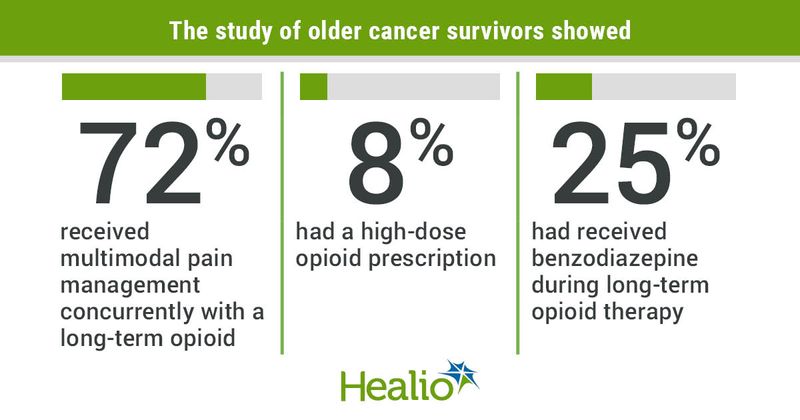Safety measures inconsistent for opioid prescribing among older cancer survivors
Efforts should be made to increase multimodal pain management and reduce inappropriate prescribing of benzodiazepine to improve the safety of long-term opioid therapy among cancer survivors, according to results of a study in Cancer.
Although the findings showed the majority of older cancer survivors who received long-term opioid therapy had been prescribed opioids safely, nearly 30% of survivors with long-term therapy did not have claims for other nonopioid analgesics or pain management procedures, and nearly as many had a concurrent prescription for benzodiazepines.

“We know from our prior work with older cancer survivors that survivors of some cancers — like lung, colorectal, and head and neck — are more likely to receive long-term opioid therapy and are more likely to use high-dose long-term opioid therapy than older adults without cancer, at least a few years after diagnosis,” Talya Salz, PhD, assistant attending outcomes research scientist in the department of epidemiology and biostatistics at Memorial Sloan Kettering Cancer Center, told Healio. “Many cancer survivors do experience chronic pain, even after treatment completion, so the increased use of opioids among some survivors may be appropriately responsive to survivors’ needs.
“However, our team wanted to know whether long-term opioid use among survivors was safe when used in conjunction with other pain management strategies, taken at low daily doses, and not used at the same time as benzodiazepines,” Salz added.

Salz and colleagues used the SEER database to evaluate 3,628 cancer survivors (81% women; 88% white; 51% aged 66-74 years at diagnosis) at least 15 months after diagnosis who were Free-for-Service Medicare beneficiaries aged 66 years or older and had been diagnosed between 2008 and 2015 with breast (n = 1,696), colorectal (n = 935), lung (n = 808) or head and neck (n = 189) cancer. To minimize the inclusion of long-term opioid therapy prescribed during cancer treatment or at the end of life in the analysis, researchers began follow-up 1 year after diagnosis and stopped at hospice entry, a second cancer diagnosis, 6 months before death or the end of 2016.
They limited the cohort to survivors who had at least one long-term opioid therapy episode between 1 year after diagnosis and the end of follow-up (median duration, 4.9 months; interquartile range, 3.5-8). They defined episodes as 90 or more consecutive days of dispensing, with 7 or fewer days allowed between prescriptions.
Salz and colleagues measured prescribing during the first 90 days of the first long-term opioid therapy episode during follow-up. They also calculated the proportion of survivors with concurrent nonopioid pain management as a positive safety indicator.
Results showed 72% of survivors had received multimodal pain management concurrently with a long-term opioid, 8% had a high-dose opioid prescription, and 25% had received benzodiazepine during long-term opioid therapy.
“I was surprised by the large amount of concurrent long-term opioid use and benzodiazepines, since the combination of these drugs can be quite toxic and can lead to fatal overdose,” Salz said.
In addition, no single factor — such as having a lot of comorbid illnesses or later-stage disease — appeared associated with all three of the safety metrics they analyzed in multivariable analyses.
“Our findings suggest that for survivors receiving long-term opioid therapy, there are different drivers of using multimodal pain management, prescribing lower doses of opioids and avoiding concurrent benzodiazepines,” Salz told Healio.
Study limitations included a lack of capturing over-the-counter co-analgesics or participation in pain management activities such as meditation, acupuncture, or cognitive behavioral therapy, and possible underestimation the risk of high-dose long-term opioid therapy because of a conservative threshold of an average of 90 morphine milligram equivalents.
Salz said further research to find out from whom survivors receive their opioid prescriptions would be helpful and may aid in identifying interventions for safer, more appropriate pain management.
“I’m very interested in understanding how primary care providers are involved in opioid prescribing for cancer survivors,” Salz said. “Primary care providers are on the forefront of managing opioids in the general (noncancer) population and they are the target of many strategies to curb opioid prescribing. At the same time, primary care providers often face challenges managing ongoing care for people who have been treated for cancer.”
The work from Salz and colleagues adds to the growing evidence that “[long-term opioid therapy] and substance use prevalence rates in cancer survivors are often higher than the mean national prevalence,” Katie Fitzgerald Jones, MSN, APN, palliative care nurse practitioner at the U.S. Department of Veterans Affairs, and Jessica S. Merlin, MD, PhD, MBA, associate professor of medicine in the division of general internal medicine at University of Pittsburgh School of Medicine, wrote in a corresponding editorial.
Jones and Merlin wrote that guidance is lacking on how to approach opioid decisions for people beyond active cancer treatment and laid out strategies for evidence-based approaches to help better tailor chronic pain and opioid decision-making for cancer survivors.
“Chronic pain and [long-term opioid therapy] are common challenges faced by cancer survivors,” they wrote. “The critical research gaps (we addressed) warrant future attention to help to guide pain and opioid decisions in the cancer survivor population, but the general literature can provide guidance for patients who need our help with managing these challenges now.”
References:
Jones KJ and Merlin MS. Cancer. 2021;doi:10.1002/cncr.33961.
Salz T, et al. Cancer. 2021;doi:10.1002/cncr.33963.
For more information:
Talya Salz, PhD, can be reached at Department of Epidemiology and Biostatistics, Memorial Sloan Kettering Cancer Center, 485 Lexington Ave., 2nd Floor, New York, NY 10017; email: salzt@mskcc.org.

